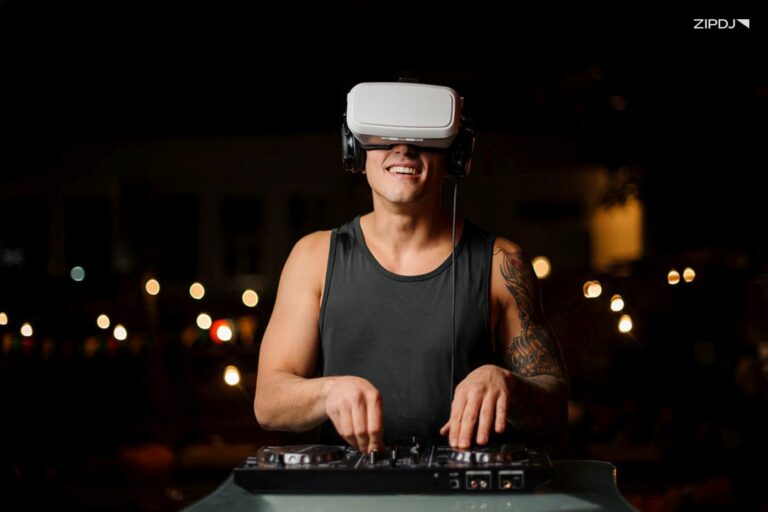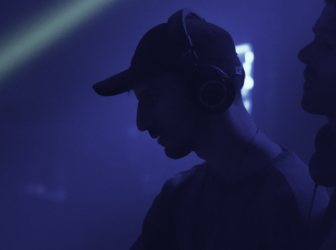How To Become A VR DJ In 2025: Virtual Reality DJ Sets

Staying on top of new technological trends is an important aspect of DJing in the modern world, and VR DJing is the next big thing.
VR DJing allows DJs to perform visually impressive virtual sets that showcase their talent while circumventing the need for expensive equipment.
In this guide, we’ve explored how to become a VR DJ, from the software options to how to build and monetize your brand.

How To Become A VR DJ In 2025: Virtual Reality DJ Sets
With a variety of technology and software to choose from, venturing into the world of virtual reality DJ sets can be like navigating a minefield.
We’ve broken down the main steps to becoming a VR DJ, from the software to how to stand out from the competition.
So, get your headsets ready, and let’s dive into everything you need to know to become a VR DJ in 2025:
What Is VR DJing?
Virtual reality DJing represents the latest frontier in the art of DJing, blending the latest in digital technology with the growing trend of online performances.
The concept is simple: VR DJing aims to replicate the experience of DJing in front of a crowd in a virtual sphere using virtual DJ gear.
This means working with fully functional virtual decks and a DJ mixer that reproduces the interactivity and functionality of their real-world counterparts.
DJs can use this virtual DJ rig to load up their tracks and perform a range of mixing techniques through an avatar, with virtual guests in the audience.
Additionally, VR DJing allows for interaction with a wide range of reactive stages and the ability to record and stream sets on various platforms.
Why DJ In VR?
There are many compelling reasons to consider DJing in virtual reality and accessing a virtual audience online in a fully customizable environment.
New trends in the field are significantly influencing how social virtual reality is ramping up the music experience and recreating the club vibe online.
Indeed, VR DJing is fast becoming a reality in the global music scene, with internationally renowned club events expanding into the VR world.
While early virtual reality technology left a lot to be desired in terms of quality and reliability, the tools and software are rapidly evolving.
More affordable and higher quality tools are emerging on the market and are suitable for various platforms, with a thriving online community of VR DJs.
How To Become A VR DJ In 2025 (Step-By-Step)
We’ve explained the basic concept behind VR DJing and why you should consider adding it to your repertoire of performances as a DJ.
Now, let’s explore the steps you’ll need to take to become a virtual DJ and acquire the necessary gear and software to host your first online event.
Step 1. Picking Your Gear: Hardware Requirements
Before you can begin DJing in VR, you’ll need to invest in the relevant hardware that allows you to participate in virtual environments.
Several popular VR headsets are available, including the Meta Quest 3, Valve’s Index VR kit, and the HTC Vive Pro series.
While these are suitable for the task, the latest Oculus and Apple Vision Pro headsets are becoming increasingly popular for DJing in VR.
Indeed, the launch of Algoriddim’s djay virtual reality software, dedicated to virtual DJing sessions, has earned praise for its 3D-modeled decks.
Designed for use with the Apple Vision Pro headsets, it can be synced with the user’s Apple Music account and combined with a range of effects.
Step 2. Researching Software Options
There is an abundance of DJ apps and software designed to help DJs take their craft online and enter the digital virtual reality sphere.
In addition to the aforementioned djay software for use with the Apple Vision Pro system, virtual DJs have options such as VRChat, Tribe XR DJ, and Vinyl Reality.
Each of these systems has its own pros and cons, including platform support and available features, to consider before making the decision.
VRChat was the first notable platform to enter the VR DJing market, but Tribe XR DJ and Vinyl Reality are fast becoming worthwhile competitors.
The ability to virtually DJ using some of the best DJ controllers through Tribe XR DJ is one reason why many DJs are switching to this platform.
Users can perform sets with a virtual version of the iconic Pioneer CDJ-3000, enjoying its flagship features at a fraction of the price of the hardware.
Conversely, Vinyl Reality offers a wealth of features and audio file format compatibility with beginner-friendly controls.
Step 3. Adapting To A VR environment
Once you’ve selected your hardware and software options, it’s time to consider how you can integrate these into your virtual DJing environment.
Virtual reality is inherently open-ended in terms of its creative potential, so the sky is the limit when it comes to the format’s possibilities.
Many virtual DJs are using the technology to recreate the spirit of the nightlife scene through the realization of virtual raves.
This includes rebuilding actual venues to reflect their authentic vibe and pushing the boundaries of what ravers expect from the experience.
It can also mean creating completely unique visual experiences for the audience that transcend the real-world source material and inspiration.
In short, VR DJing’s potential to experiment with the format and create environments that reshape live dance music is near-limitless.
Step 4. Curating Music For VR Experience
With the potential for performing DJ sets in completely original and unique virtual spaces, DJs need to reconsider their approach to music curation.
This means curating playlists that are more in tune with their place in the visual experience and how they can form an interactive symbiosis.
In a sense, this approach is not dissimilar to the concept of video DJing, which has been around for many years and combines imagery with music.
VDJs have plenty of experience working in the audio-visual space and coordinating the footage with the ebbs and flows of their DJ sets.
Many of these principles that incorporate the use of colors, animations, and other visual effects are equally applicable to the VR DJing landscape.
As such, the music should reflect this fusing of mediums, taking the audience on a journey that is as much visual as it is musical.
Step 5. Integrating Virtual Environments & Special Effects
To elaborate on the previous step, let’s explore in more detail how you can use virtual environments and effects to create an immersive experience.
While the aforementioned VDJs worked with large screens and displays to create an immersive experience, VR DJs can take it further.
Not restricted by a two-dimensional display, they can craft environments in which the audience can move within the space in new and exciting ways.
This opens up new creative opportunities for VR DJs, moving away from the restrictions of the real world and into otherworldly territories.
At the same time, the ability to include impressive visual effects can further enhance the audience’s experience and sense of wonder.
Disco lights, lasers, and other effects from real-world clubs can be enhanced with tangible projected visual assets for a more immersive experience.

Step 6. Pre-Performance Prep
One of the most important aspects of DJing, whether in the real or virtual world, is time management, and this is equally vital for VR DJing.
Before launching your VR DJ set, you should take the time to prepare for all eventualities in advance to ensure you deliver a great performance.
This begins with an equipment check to see if there are any problems that need to be addressed before you begin broadcasting your set.
You should also ensure you’ve properly promoted your upcoming set on your social media pages and other online platforms.
Step 7. Live VR DJ Performance
After thorough preparation, including creating a playlist and establishing the visual tone, it’s time to perform your VR DJ set.
The principle here is similar to a traditional in-person DJ set, with great energy levels and audience interaction being important parts of success.
Additionally, you can include real-time comments from the audience in a similar fashion to DJs who perform on platforms such as Twitch.
If you need additional inspiration, research some of the big names in the business and how they use VR to create an immersive experience.
For example, Tomorrowland launched an immersive VR audiovisual exhibition, creating an enhanced spectacle with virtual firework displays.
Step 8. Post-Performance Analysis
Once you’ve finished your set, it’s time to review the material to determine what worked and what areas could be improved.
You can rewatch and analyze your VR DJ set to see how effectively your mixing techniques were integrated into the overall experience.
Gathering feedback from the audience is another great way to address any issues that you might otherwise have missed from your review.
This includes monitoring the audience’s participation levels and identifying any weak points or tracks that fail to land.
Step 9. Building Your VR DJ Brand
If you’re serious about making a mark on the VR DJing scene, you’ll need to work on building a brand that is recognizable and popular.
Many of the tactics used to do this will be similar to traditional DJing, from creating brand assets to choosing a catchy and memorable DJ name.
It also includes creating a virtual avatar that reflects your DJing personality and provides an eye-catching focal point for virtual audiences.
You can promote your VR DJ brand on social media platforms and use other streaming services to raise awareness of upcoming virtual gigs.
Step 10. Monetizing VR DJ Sets
While monetization methods for VR DJing are still in their infancy, it’s nevertheless possible to earn money DJing virtual spaces.
Indeed, the format’s early days mean that getting your foot in the door now could lead to big gains in the future.
Several methods for monetizing are already open to virtual DJs, including the opportunity for audience members to leave virtual tips.
You can also create ticketed events on various VR DJing platforms and work with brand partners to advertise their products in your virtual environment.
If you’re serious about including VR DJing in your overall brand, make sure you include this information in your DJ pricing when promoting your services.
The VR DJ Community
While VJ DJing is still in its infancy, a growing online community is interested in sharing their experiences and insights on the technology.
Online forums dedicated to the topic are complemented by a variety of communities, from Reddit threads to dedicated VR DJing forums.
As the concept gains ground, we can anticipate an expansion of competitions and events showcasing the most talented VR DJs.
Likewise, software developers such as Tribe XR DJ Academy are already offering daily workshops to help users take their performances to the next level.
The Future Of VR DJing
VR DJing is still in its early days, but it will undoubtedly continue to evolve, with significant improvements in audiovisual quality and performance.
Currently, virtual hardware and guest limitations exist, but these will fade over time as developers hone their platforms.
Likewise, with the future of music increasingly intertwined with artificial intelligence, DJs can anticipate greater interaction with their virtual environments.
It’s a rapidly evolving landscape that looks set to draw increasingly larger virtual audiences in the future and a viable companion to in-person DJ sets.
Summary
It may be early days for virtual reality DJing, but the format already has a growing fan base and plenty of long-term potential.
Thanks to this guide, DJs can begin with this emerging technology on the right foot and explore its possibilities for performances.
As technology continues to improve, VR DJing is likely to enjoy exponential growth and reach an increasingly large and dedicated audience.
Not a member ?
Join Today for Unlimited Music Downloads. Visit zipdj.com for more information.



